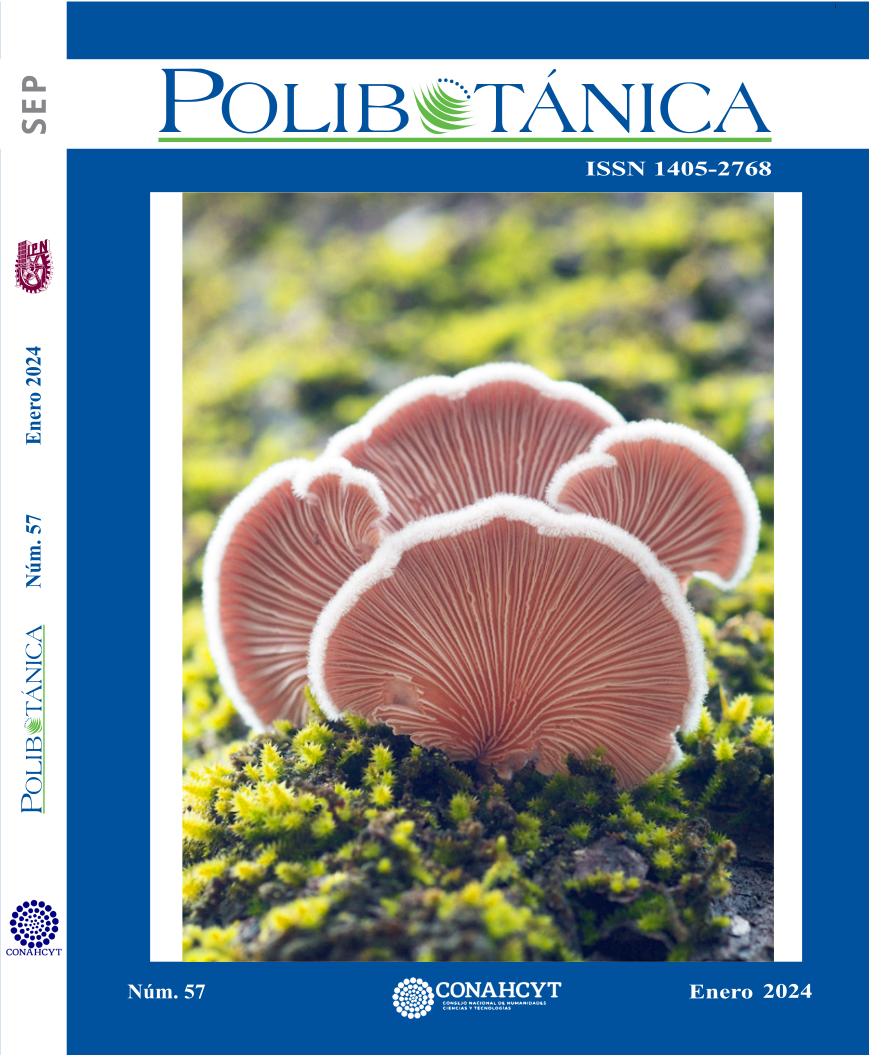Acaricidal and ovicidal effect of the essential oils of Chenopodium ambrosioides L. and Peperomia inaequalifolia Ruiz & Pav. against Tetranychus urticae in strawberry (Fragaria spp.)
DOI:
https://doi.org/10.18387/polibotanica.57.14Keywords:
Peperomia inaequalifolia, Tetranychus urticae, ovicidal, acaricide, essential oilAbstract
The objective of this study was to evaluate the acaricidal effect of the essential oils from Chenopodium ambrosioides L. and Peperomia inaequalifolia Ruiz & Pav. on eggs and adult females of Tetranychus urticae, present on strawberry plants (Fragaria spp). The essential oils were obtained through steam distillation and analyzed using the gas chromatography-mass spectrometry (GC/MS) technique. The oils were diluted in dimethyl sulfoxide (DMSO) at concentrations ranging from 0.5% to 4% for ovicidal assays and 2.5% to 0.125% for acaricidal tests. These solutions were brought into contact with T. urticae eggs to assess their viability and with adult mite females to determine the lethality as CL50 in randomized treatments. Tetradifon (ovicidal) and abamectin (acaricidal) were used as positive controls, and DMSO as the negative control. The chemical analysis of the oils revealed that the most abundant molecules in C. ambrosioides were sylvestrene (18,68 %), trans-p-Mentha-2,8-dienol (18,06 %), trans-p-mentha-1(7),8-dien-2-ol (11,75%) and cis-p-mentha-1(7),8-dien-2-ol (11,74%); while in P. inaequalifolia, elemicin (36,33%) and myristicin (20.21%) were predominant. Individual essential oils proved to be highly effective in inhibiting the development of mite eggs. Trials with adult females exhibited variability in response to the essential oils, with high lethality in P. inaequalifolia and modest lethality in C. ambrosioides. Overall, significant activity was observed in the oils and their mixtures as ovicides, with P. inaequalifolia standing out as oil with acaricidal potential
References
Adesanya, A. W., Lavine, M. D., Moural, T. W., Lavine, L. C., Zhu, F., & Walsh, D. B. (2021). Mechanisms and management of acaricide resistance for Tetranychus urticae in agroecosystems. In Journal of Pest Science (Vol. 94, Issue 3). https://doi.org/10.1007/s10340-021-01342-x
Afify, A. E. M. M. R., Ali, F. S., & Turky, A. F. (2012). Control of Tetranychus urticae Koch by extracts of three essential oils of chamomile, marjoram and Eucalyptus. Asian Pacific Journal of Tropical Biomedicine, 2(1). https://doi.org/10.1016/S2221-1691(11)60184-6
Aglagane, A., Laghzaoui, E. M., Soulaimani, B., Er-Rguibi, O., Abbad, A., Mouden, E. H. El, & Aourir, M. (2022). Acaricidal activity of Mentha suaveolens subsp. timija, Chenopodium ambrosioides, and Laurus nobilis essential oils, and their synergistic combinations against the ectoparasitic bee mite, Varroa destructor (Acari: Varroidae). Journal of Apicultural Research, 61(1). https://doi.org/10.1080/00218839.2021.1898787
Aguilar, G., Calva, J., Cartuche, L., Salinas, M., & Armijos, C. (2023). Chemical Constituents, Enantiomer Content, Antioxidant and Anticholinesterase Activities of Valeriana microphylla Kunth Essential Oil. Plants, 12(11). https://doi.org/10.3390/plants12112155
Aragón, J. P., Parra, E., Chicaiza, Á., & Aragón, M. (2019). Análisis de la cadena agroproductiva de cebada (Hordeum vulgare) del Carchi y frutilla (Fragaria sp) en Pichincha. Natura@economía, 4(2). https://doi.org/10.21704/ne.v4i2.1410
Babushok, V. I., Linstrom, P. J., & Zenkevich, I. G. (2011). Retention Indices for Frequently Reported Compounds of Plant Essential Oils. Journal of Physical and Chemical Reference Data, 40(4). https://doi.org/10.1063/1.3653552
Bamel, K., & Gulati, R. (2021). Biology, population built up and damage potential of Red spider mite, Tetranychus urticae Koch (Acari: Tetranychidae) on marigold: A review. Journal of Entomology and Zoology Studies, 9(1). https://doi.org/10.22271/j.ento.2021.v9.i1h.8201
Chekem, M. S. G., Lunga, P. K., Tamokou, J. de D., Kuiate, J. R., Tane, P., Vilarem, G., & Cerny, M. (2010). Antifungal properties of Chenopodium ambrosioides essential oil against candida species. Pharmaceuticals, 3(9). https://doi.org/10.3390/ph3092900
Deaquiz Oyola, Y. A., Torres cabra, E., & Espinosa Suarez, C. L. (2022). Actividad acaricida in vitro del aceite esencial de tomillo contra el ácaro rojo (Dermanyssus gallinae). Revista de Investigación Agraria y Ambiental, 14(1). https://doi.org/10.22490/21456453.5822
İnak, E., Alpkent, Y. N., Çobanoğlu, S., Dermauw, W., & Van Leeuwen, T. (2019). Resistance incidence and presence of resistance mutations in populations of Tetranychus urticae from vegetable crops in Turkey. Experimental and Applied Acarology, 78(3). https://doi.org/10.1007/s10493-019-00398-w
Jaramillo C, B. E., Duarte R, E., & Delgado, W. (2012). Bioactivity of essential oil from Colombian Chenopodium ambrosioides. Revista Cubana de Plantas Medicinales, 17(1).
Jardim, C. M., Jham, G. N., Dhingra, O. D., & Freire, M. M. (2008). Composition and antifungal activity of the essential oil of the brazilian Chenopodium ambrosioides L. Journal of Chemical Ecology, 34(9). https://doi.org/10.1007/s10886-008-9526-z
Kasali, F. M., Tusiimire, J., Kadima, J. N., & Agaba, A. G. (2021). Ethnomedical uses, chemical constituents, and evidence-based pharmacological properties of Chenopodium ambrosioides L.: extensive overview. Future Journal of Pharmaceutical Sciences, 7(1). https://doi.org/10.1186/s43094-021-00306-3
Kouam, M. K., Payne, V. K., Miégoué, E., Tendonkeng, F., Lemoufouet, J., Kana, J. R., Boukila, B., Pamo, E. T., & MNM, B. (2015). Evaluation of In Vivo Acaricidal Effect of Soap Containing Essential Oil of Chenopodium ambrosioides Leaves on Rhipicephalus lunulatus in the Western Highland of Cameroon . Journal of Pathogens, 2015. https://doi.org/10.1155/2015/516869
Liu, Z., Wu, F., Liang, W., Zhou, L., & Huang, J. (2022). Molecular Mechanisms Underlying Metabolic Resistance to Cyflumetofen and Bifenthrin in Tetranychus urticae Koch on Cowpea. International Journal of Molecular Sciences, 23(24). https://doi.org/10.3390/ijms232416220
Mendoza Léon, D., Dobronski Arcos, J., Vásquez Freytez, C., Frutos Pinto, V., & Paredes Carreño, S. (2018). Control de Tetranychus urticae koch (Acari: Tetranychidae) con Bacillus subtilis en hojas de fresa (Fragancia vesca). Agronomía Costarricense. https://doi.org/10.15517/rac.v43i1.35676
Miresmailli, S., Bradbury, R., & Isman, M. B. (2006). Comparative toxicity of Rosmarinus officinalis L. essential oil and blends of its major constituents against Tetranychus urticae Koch (Acari: Tetranychidae) on two different host plants. Pest Management Science, 62(4). https://doi.org/10.1002/ps.1157
Namin, H. H., Zhurov, V., Spenler, J., Grbić, M., Grbić, V., & Scott, I. M. (2020). Resistance to pyridaben in Canadian greenhouse populations of two-spotted spider mites, Tetranychus urticae (Koch). Pesticide Biochemistry and Physiology, 170. https://doi.org/10.1016/j.pestbp.2020.104677
Noriega Rivera, P. (2009). Extracción, química, actividad biológica, control de calidad y potencial económico de los aceites esenciales. La Granja, 10(2). https://doi.org/10.17163/lgr.n10.2009.01
Nunes, G., & Novello, D. (2021). MORANGO (FRAGARIA X ANANASSA DUCH): PRODUTIVIDADE, COMPOSIÇÃO QUÍMICA, NUTRICIONAL E SENSORIAL. Revista Valore, 6. https://doi.org/10.22408/reva602021279e-6002
Nwanade, C. F., Wang, M., Wang, T., Zhang, X., Zhai, Y., Zhang, S., Yu, Z., & Liu, J. (2021). The acaricidal activity of cinnamon essential oil: current knowledge and future perspectives. International Journal of Acarology, 47(5). https://doi.org/10.1080/01647954.2021.1936632
Patel, N. B., Bhatt, N. A., & Patel, C. C. (2020). Effect of weather parameters on incidence of brinjal mite, Tetranychus urticae Koch and its predatory mite, Amblyseius alstoniae Gupta. Journal of Pharmacognosy and Phytochemistry, 9(4), 3095–3099.
Rivera, P. N., Mosquera, T., Baldisserotto, A., Abad, J., Aillon, C., Cabezas, D., Piedra, J., Coronel, I., & Manfredini, S. (2015). Chemical Composition and in-vitro biological activities of the essential oil from leaves of Peperomia inaequalifolia Ruiz & Pav. In ~ 29 ~ American Journal of Essential Oils and Natural Products (Vol. 2, Issue 4).
Santacruz Paola, Noriega Paco (2016). La Congona: Evaluación del efecto acaricida del aceite esencial de las hojas de Congona sobre ácaros de frutilla. Editorial Académica Española. Madrid España
Schmidt-Jeffris, R. A., Coffey, J. L., Miller, G., & Farfan, M. A. (2021). Residual Activity of Acaricides for Controlling Spider Mites in Watermelon and Their Impacts on Resident Predatory Mites. Journal of Economic Entomology, 114(2). https://doi.org/10.1093/jee/toaa320
Schulze, T. L., & Jordan, R. A. (2021). Synthetic pyrethroid, natural product, and entomopathogenic fungal acaricide product formulations for sustained early season suppression of host-seeking ixodes scapularis (Acari: Ixodidae) and Amblyomma americanum nymphs. Journal of Medical Entomology, 58(2). https://doi.org/10.1093/jme/tjaa248
Selles, S. M. A., Kouidri, M., González, M. G., González, J., Sánchez, M., González-Coloma, A., Sanchis, J., Elhachimi, L., Sonia Olmeda, A., Tercero, J. M., & Valcárcel, F. (2021). Acaricidal and repellent effects of essential oils against ticks: A review. In Pathogens (Vol. 10, Issue 11). https://doi.org/10.3390/pathogens10111379
Valarezo, E., Herrera-García, M., Astudillo-Dávila, P., Rosales-Demera, I., Jaramillo-Fierro, X., Cartuche, L., Meneses, M. A., & Morocho, V. (2023). Study of the Chemical Composition and Biological Activity of the Essential Oil from Congona (Peperomia inaequalifolia Ruiz and Pav.). Plants, 12(7). https://doi.org/10.3390/plants12071504
Wu, Y., Ren, D., Gao, C., Li, J., Du, B., Wang, Z., & Qian, S. (2021). Recent advances for alkaloids as botanical pesticides for use in organic agriculture. In International Journal of Pest Management. https://doi.org/10.1080/09670874.2021.1917723
Downloads
Published
Issue
Section
License

Polibotánica by Departamento de Botánica de la Escuela Nacional de Ciencias Biológicas del Instituto Politécnico Nacional se distribuye bajo una Licencia Creative Commons Atribución-NoComercial-CompartirIgual 4.0 Internacional.




















